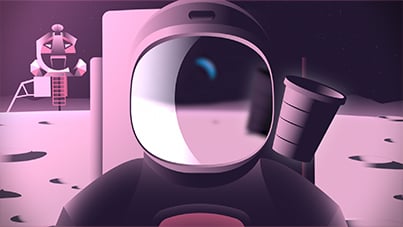Waar ben je naar op zoek?
Meest gezocht
Andere zochten naar...
Populaire diensten
Onze populairste diensten en oplossingen
Opdrachtgever:
Cooler Media
Partner:
European Space Agency (ESA)
Onderwerp:
Ruimteafval en het Kessler Syndroom
Stijl:
AnyStory
Taal:
Engels
Verhaal:
De mens laat schadelijke sporen achter, ook buiten het aardoppervlak. Ruimteafval, oftewel Space Debris, zorgt daarom voor een groot probleem. Hierdoor ontstaat het Kessler Syndroom. Wij doken met de ESA in het ruimteafval (nou ja, de impact ervan) rondom onze planeet en de oplossingen. Bekijk de gehele AnyStory. 🚀

“Modern societies are increasingly dependent on applications and services through a space-based infrastructure. The growth of space debris puts the sustainable use of space at risk and ESA is very interested in raising the awareness about space debris. Working on an animation addressing space debris with the team of Cooler Media has been an excellent opportunity resulting in a concise, appealing, and content-rich video that supports ESA’s outreach spot-on.”

Wat is ruimteafval?
Ruimteafval ofwel Space Debris, is elk kunstmatig stuk dat door mensen in een baan om de aarde wordt achtergelaten zonder een functie. Denk aan oude satellieten, delen van een raket of zelfs kleine verfvlekken. Er zijn al meer dan een miljoen stukken ruimteafval groter dan 1 centimeter gedetecteerd. Kun je voorstellen hoeveel kleinere, niet-gedetecteerde stukjes daar bij komen. Vanwege het groeiend aantal ruimtemissies zal dit aantal naar verwachting de exponentieel groeien in de toekomst.

Waarom is ruimteafval een probleem?
Het meest voor de hand liggende is dat grote objecten ruimteschroot de werkende satellieten beschadigen en de communicatie op aarde verstoren. Het ergste scenario? Wanneer twee stukken ruimteafval botsen, produceren ze kleinere stukken. Deze stukken zullen verder botsen met andere stukken en het proces zal zich herhalen. Dit effect staat bekend als het Kessler-syndroom. Al deze objecten van ruimtepuin zouden het moeilijker kunnen maken, of zelfs onmogelijk om ooit nog de ruimte in te gaan…

Is er een oplossing?
Er is geen overheidscontrole is op ruimtevaartactiviteiten, alleen internationale richtlijnen. Daarom nam de Global Future Council on Space Technologies van het World Economic Forum het heft in eigen handen. Door o.a. samen te werken met de ESA aan een schaal om de duurzaamheid van een ruimtemissie te beoordelen, hoopt zij verandwoord gedrag in de ruimte te stimuleren. Deze Space Sustainability Rating zal bovendien in de toekomst de transparantie over het lozen van Space Debris vergroten.

“Ik vind alles wat met de ruimte te maken heeft heel intrigerend, dus het was een fantastisch onderwerp om een video over te maken. Daarnaast was de kans om voor de ESA te werken natuurlijk heel tof!”
Bij Cooler Media besteden we een groot deel van onze tijd aan vrij werk in de vorm van de AnyStories. De enige vereiste: ‘Maak het vet!’
Voor deze AnyStory over ruimtepuin heeft designer & animator Robin in alle vrijheid een unieke, coole stijl ontwikkeld. Er is gekozen voor jaren ’80 neon ‘space’ kleuren, die een science fiction look geven aan de video.
In het design is gewerkt met een compositie vanuit het middelpunt met details aan de zijkant. Dit zorgt ervoor dat iedere scene uit de video een poster zou kunnen zijn. De designelementen zijn subtiel geanimeerd. Hier is voor gekozen om de video rustig te houden en de boodschap goed over te brengen.
Schrijf je in voor de Spotlight en ontvang één keer per maand een e-mail met tips, trends, cases, blogs en onze nieuwste creaties.
Space, the final frontier and a trillion-dollar industry according to the latest estimations. More and more companies are sending rockets and satellites into space. But chances are this new commercial space race will end before it can really take off…
Since the dawn of space exploration, humankind has left a lot of stuff in earth’s orbit. Rocket parts, old satellites and other junk amounts to more than thirty thousand large pieces and millions of smaller parts of debris currently flying around our planet. For some pieces, it will take hundreds of years for them to fall back and burn up in our atmosphere. Some may even stay up there forever.
Now watch wat happens when two pieces collide more and more debris is created. This cascading effect is called the Kessler Syndrome. The debris will become a huge swarm that forms a shell around the planet, destroying our satellites and knocking out global communication on the planet. The debris in our orbit would also prevent us from further space exploration and trap us on earth! It’s a big problem that won’t solve itself. So, what can we do?
First, we need to see the orbits around earth as a finite resource, like any other we rely on. Use too much of it and there will be nothing left. To do this we need to regulate space traffic and waste disposal on a global scale. But that will take decades…
Commercial space organizations might offer a faster solution. A huge industry could be lost if they themselves do not act on the problem. The costs of evading debris and constantly adjusting to a growing swarm of junk is extremely high. A clean orbit directly influences their return on investment. Building satellites and rockets that don’t leave debris is the most important step but we also need to clean up our mess.
In 2012 the European Space Agency started the clean space initiative to minimize space activities’ impact on the Earth environment. It also aims to reduce the production of space debris and remove debris from orbit. One of the current ideas is to use a giant space garbage truck with tentacles that can grab larger pieces of debris. Other ideas propose using robotic systems to catch the bigger chunks. Living in perfect harmony with our environment is a goal to strive for, on earth and in orbit. So that maybe one day, we can all look at our old home from space.